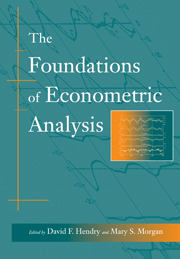Book contents
- Frontmatter
- Contents
- Preface
- Acknowledgements
- Introduction
- Bibliography
- I The Emerging Role of Econometrics in Economics
- II Early Time-Series Analysis
- 6 On the Study of Periodic Commercial Fluctuations (Read to the British Association in 1862, and in Investigations in Currency and Finance, Macmillan, 1884, pp. 3–10 and plates)
- 7 Correlation of the Marriage-Rate with Trade (Journal of the Royal Statistical Society, vol. 64, 1901, pp. 485–92)
- 8 The Correlation of Economic Statistics (Journal of the American Statistical Association, vol. 12, 1910, pp. 289–94, 306–17 (cut))
- 9 Why do we sometimes get Nonsense Correlations between Time-Series? (Journal of the Royal Statistical Society, vol. 89, 1926, pp. 2–9, 30–41)
- 10 On a Method of Investigating Periodicities in Disturbed Series, with Special Reference to Wolfer's Sunspot Numbers (Philosophical Transactions of the Royal Society of London, A, vol. 226, 1927, pp. 267–73)
- 11 A Random-Difference Series for Use in the Analysis of Time Series (Journal of the American Statistical Association, vol. 29,934, pp. 11–24 (data cut))
- 12 Calculation and Elimination of Seasonal Fluctuations [Berechnung und Ausschaltung von Saisonschwankungen] (Julius Springer, Vienna, 1936, chap. 1)
- 13 Morgenstern on the Methodology of Economic Forecasting (Journal of Political Economy, vol. 37, 1929, pp. 312–17, 320–3, 326–37 (cut))
- III Applied Econometrics and the Identification Problem
- IV The Evolution of Statistical Thinking in Econometrics
- V Dynamic Models
- VI The Tinbergen Debate
- VII Structure and Simultaneity
- VIII The Probabilistic Revolution
- IX Exogeneity
- Index
10 - On a Method of Investigating Periodicities in Disturbed Series, with Special Reference to Wolfer's Sunspot Numbers (Philosophical Transactions of the Royal Society of London, A, vol. 226, 1927, pp. 267–73)
Published online by Cambridge University Press: 05 June 2012
- Frontmatter
- Contents
- Preface
- Acknowledgements
- Introduction
- Bibliography
- I The Emerging Role of Econometrics in Economics
- II Early Time-Series Analysis
- 6 On the Study of Periodic Commercial Fluctuations (Read to the British Association in 1862, and in Investigations in Currency and Finance, Macmillan, 1884, pp. 3–10 and plates)
- 7 Correlation of the Marriage-Rate with Trade (Journal of the Royal Statistical Society, vol. 64, 1901, pp. 485–92)
- 8 The Correlation of Economic Statistics (Journal of the American Statistical Association, vol. 12, 1910, pp. 289–94, 306–17 (cut))
- 9 Why do we sometimes get Nonsense Correlations between Time-Series? (Journal of the Royal Statistical Society, vol. 89, 1926, pp. 2–9, 30–41)
- 10 On a Method of Investigating Periodicities in Disturbed Series, with Special Reference to Wolfer's Sunspot Numbers (Philosophical Transactions of the Royal Society of London, A, vol. 226, 1927, pp. 267–73)
- 11 A Random-Difference Series for Use in the Analysis of Time Series (Journal of the American Statistical Association, vol. 29,934, pp. 11–24 (data cut))
- 12 Calculation and Elimination of Seasonal Fluctuations [Berechnung und Ausschaltung von Saisonschwankungen] (Julius Springer, Vienna, 1936, chap. 1)
- 13 Morgenstern on the Methodology of Economic Forecasting (Journal of Political Economy, vol. 37, 1929, pp. 312–17, 320–3, 326–37 (cut))
- III Applied Econometrics and the Identification Problem
- IV The Evolution of Statistical Thinking in Econometrics
- V Dynamic Models
- VI The Tinbergen Debate
- VII Structure and Simultaneity
- VIII The Probabilistic Revolution
- IX Exogeneity
- Index
Summary
Introductory: Superposed Fluctuations and Disturbances
If we take a curve representing a simple harmonic function of the time, and superpose on the ordinates small random errors, the only effect is to make the graph somewhat irregular, leaving the suggestion of periodicity still quite clear to the eye. Figure 10.1 (a) shows such a curve, the random errors having been determined by the throws of dice. If the errors are increased in magnitude, as in figure 10.1(b), the graph becomes more irregular, the suggestion of periodicity more obscure, and we have only sufficiently to increase the ‘errors’ to mask completely any appearance of periodicity. But, however large the errors, periodogram analysis is applicable to such a curve, and, given a sufficient number of periods, should yield a close approximation to the period and amplitude of the underlying harmonic function.
When periodogram analysis is applied to data respecting any physical phenomenon in the expectation of eliciting one or more true periodicities, there is usually, as it seems to me, a tendency to start from the initial hypothesis that the periodicity or periodicities are masked solely by such more or less random superposed fluctuations – fluctuations which do not in any way disturb the steady course of the underlying periodic function or functions. It is true that the periodogram itself will indicate the truth or otherwise of the hypothesis made, but there seems no reason for assuming it to be the hypothesis most likely a priori.
- Type
- Chapter
- Information
- The Foundations of Econometric Analysis , pp. 159 - 165Publisher: Cambridge University PressPrint publication year: 1995
- 3
- Cited by

